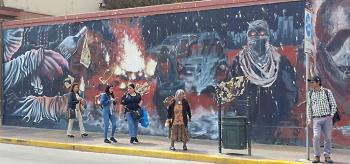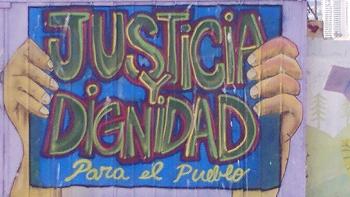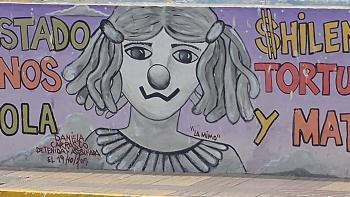A glimpse of Chile unrest
This item appears on page 20 of the August 2021 issue.
My husband, Paul, and I embarked the M/S Marina in Buenos Aires, Argentina, on Feb. 24, 2020, for the “Mystical Fjords” itinerary of Oceania Cruises (855/335-2588, www.oceaniacruises.com). The cruise was scheduled to end in Lima, Peru, on March 15, 2020.
A sense of unease hung over our trip, and not only because of COVID-19 fears. Civil unrest had ignited throughout Chile a few months earlier, in October, triggered by a CLP30 peso (4%) increase in metro fares in Santiago during peak hours. Turnstile jumping and countrywide mass protests devolved into looting, burning and deaths. At each Chilean port, the civil unrest was palpable.
Valparaíso’s elegant facades were scrawled with graffiti. A prominent graffiti image seen everywhere was a giant eye. A street vendor sold us a refrigerator magnet picturing a bandana-clad dog jumping a turnstile — another popular image of the unrest.
In Viña de Mar, officials removed the hands of the historic floral clock to prevent their being damaged or taken by vandals or protesters.
One day, after the ship docked in Puerto Montt, passengers traveled in a downpour across the Andes to the city of Coyhaique. The bus windows steamed up and we couldn’t see outside. As we climbed, the sun broke through and we got a view of agricultural valleys and small farms.
We were going to visit a local crafts market, but when we arrived, the craftspeople had scattered, their tables abandoned, in anticipation of a march protesting the exclusion of the citizens in writing a new constitution. The rumored demonstrators didn’t show up, and gradually the vendors trickled back to their tables.
•
Paul and I spent March 11 in Coquimbo exploring on foot. Switchback stairways connect the commercial area with a residential area. We picked one and started climbing. Between the switchback stairs, there were red geraniums, a giant Chilean wine palm and trash competing for space.
Coquimbo’s claim to fame is the massive Cruz del Tercer Milenio, atop the city’s most prominent hill, and when we met a friendly local walking his little dog, named Benji, he urged us to visit the Cruz, which was not far off. But we were more interested in the squat orange, yellow and green houses and the view looking down to the harbor.
We sat awhile on a wrought-iron bench on the commercial street and people-watched while a band played “I Love Paris.” Several dogs were sprawled out on the bandstand at the musicians’ feet, unperturbed by the brass and percussion. Across from the square was the arson-scorched edifice of the Iglesia San Pedro.
As we sat there, a silent group of marchers entered the square, the leaders wearing black balaclavas. The band stopped playing and started packing up. The marchers proceeded diagonally across the plaza and into a small street, where they banged things against metal walls and shouted. The bulk of the marchers were teenagers in school uniforms, both boys and girls. No police showed up.
By the pier, vendors had set up booths. We bought a couple of cloth bags made by local women. One shopping bag has an image of Frida Kahlo wearing a red mask over her mouth, with a crown of red flowers. Under her head are the words “Abandona a tu Diego Rivera” (“Abandon your Diego Rivera”).
The second bag has a screen print of a city scene in red, orange and yellow. The city is in flames. It also depicts the refrigerator-magnet dog with his red bandana, soldiers pointing machine guns at clenched fists, a flying saucer in the sky, and lots of Chilean flags.
•
About an hour before we set sail, a minivan pulled up next to our ship. A local band, the same band we saw playing in the park, climbed out. They commenced to play “I Love Paris” again. We leaned on our veranda railing and applauded, as did passengers lining verandas above ours. From a balcony above us, red roses drifted and twirled slowly onto the pier.
The band ended with a rendition of “Auld Lang Syne,” and we all sang along. After a final toot of a trombone, the deckhands raised the anchor, and the next phase of our voyage commenced.
At 6 p.m. on March 14, our captain announced that the ship was turning back. Peru had closed ports. The first positive case of COVID-19 had appeared in Lima on March 6.
Thus began nine days of sailing up and down the west coast of South America in search of a welcoming port, followed by two days at anchor in the Gulf of Panama awaiting permission to transit the Panama Canal. We finally docked in Miami on March 23.
BETSY LEWIS
Kirkland, WA



